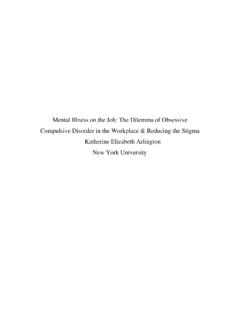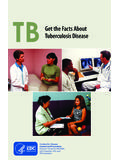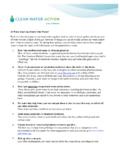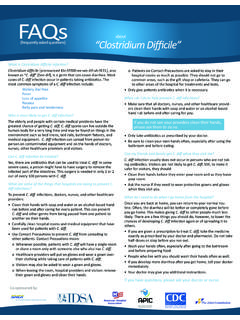Transcription of NAME: FORM: YEAR 10 Home Economics - Portadown
1 1 NAME: _____ form : _____ year 10 home Economics FOOD SAFETY, HYGIENE AND FOOD POISONING 2 How to prepare and cook food safely Studies show that the kitchen contains the most germs in the home . It was found that the kitchen sink contains 100,000 times more germs than the bathroom. Germs such as E. coli, campylobacter and salmonella enter the kitchen on our hands, raw food and through our pets. They can rapidly spread if we're not careful. If food isn t washed, cooked, stored and handled correctly, people can become ill with food poisoning, colds, flu and other conditions.
2 Washing hands Our hands are the main way germs are spread, so it s important to wash them thoroughly with soap and warm water before cooking and after touching raw meat. Raw meat, including poultry, contains harmful bacteria that can spread easily to anything it touches. This includes other food, worktops, tables, chopping boards and knives. Lots of people think they should wash raw chicken, but there's no need," says nutrition expert Sam Montel. "Any germs on it will be killed if you cook it thoroughly. In fact, if you do wash chicken, you could splash germs on to the sink, worktop, dishes or anything else nearby.
3 Take particular care to keep raw meat away from ready-to-eat foods such as bread, salad and fruit. These foods won t be cooked before you eat them so any germs that get on to them won t be killed. When storing raw meat, always store it on the bottom shelf of the fridge where it can t touch or drip on to other foods. 3 Cooking and cleaning 1. Meat and poultry Don t eat these foods rare (not thoroughly cooked): poultry pork burgers sausages rolled joints of meat kebabs Cooking food at the right temperature will ensure that any harmful bacteria are killed.
4 Check that food is piping hot right through to the middle before you eat it (63oC and above). When cooking burgers, sausages, chicken and pork, cut into the middle to check that the meat is no longer pink and that it s piping hot (steam is coming out). When cooking a whole chicken, pierce the thickest part of the leg (between the drumstick and the thigh) to check that the juices are no longer pink or red. It s safe to serve steak and other whole cuts of beef and lamb rare (not cooked in the middle) or blue (seared on the outside) as long as they have been properly sealed (cooked quickly and at a high temperature on the outside only) to kill any bacteria on the meat s surface.
5 2. Fruit and vegetables It's advisable to wash fruit and vegetables under cold running water before you eat them. This helps to remove visible dirt as well as germs that may be on the surface of your fruit and vegetables. Peeling or cooking fruit and vegetables can also remove these germs. 4 3. Cleaning up Wash all worktops and chopping boards before and after cooking as they are sources of germ cross-contamination. Damp sponges and cloths are the perfect place for bacteria to breed. Studies have shown the kitchen sponge to have the highest number of germs in the home .
6 Wash and replace kitchen cloths, sponges and tea towels frequently. 5 Conditions for Growth of Bacteria Refer to: Essential food Hygiene The Royal Society for the Promotion of Health and answer the following questions. 1. Bacteria are living organisms, to enable them to grow they require 4 conditions, name these. (i) _____ (ii) _____ (iii) _____ (iv) _____ Bacteria grow by splitting in two when the conditions are right. This process is called binary fission. The correct conditions for bacterial growth are moisture, time, food and warmth.
7 2. Draw the Life and Death of bacteria diagram (pg 18) 6 3. Complete these sentences. (a) Bacteria will grow rapidly in foods particularly if they are within the danger zone of _____. (b) Bacteria do not grow or grow only very slowly at temperatures below _____. (c) They do not grow at temperatures above _____. 4. Why is it important to ensure a food is reheated properly? (Page 45) _____ 5. A fridge should operate between _____ and _____. 6. Freezers keep food at a temperature of _____. 7. Explain the following terms (a) Cook chill - _____ _____ (b) Cook freeze - _____ _____ 8.
8 Explain the term cold spots when referring to cooking using the microwave. _____ 7 Food poisoning Food poisoning is an illness caused by eating contaminated food. The poisoning bacteria stick to the lining of the intestine and destroy those cells by the toxins or poisons they produce. The bacteria are ingested and symptoms will generally be in this part of the body nausea, vomiting. Most people will get better without the need for treatment. In most cases, the food that causes the illness has been contaminated by bacteria, such as salmonella or a virus.
9 The symptoms of food poisoning usually begin one to three days after eating contaminated food. They include: feeling sick vomiting diarrhea stomach cramps When a person swallows food poisoning bacteria the delay before symptoms begin is termed the incubation period. Foods that are particularly vulnerable to contamination if they are not handled, stored or cooked properly include: raw meat and poultry 'ready to eat' foods such as cooked sliced meats, pate, soft cheeses and pre-packed sandwiches cooked rice gravy dairy products, such as eggs and milk 8 How common is food poisoning?
10 Each year it is estimated that as many as million people in the UK may suffer from food poisoning. In 2005 1,409 cases of food poisoning were reported in Northern Ireland. During 2010, there were 84,560 cases of food poisoning reported in England and Wales. However, the actual figure may be considerably higher than this because many people with mild symptoms do not report them and may be unaware that they are suffering from food poisoning. Outlook Most people with food poisoning will get better without the need for treatment. In the meantime, you can relieve the symptoms of food poisoning by: drinking plenty of fluids eating easily digested food, such as toast, until you feel better resting Occasionally, food poisoning can have more serious effects on a person s health, particularly if they are vulnerable to the effects of an infection.







